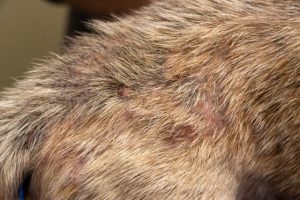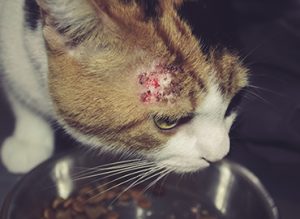 Fleas make pet’s lives miserable, and humans begin to itch just at the thought of them. The adult flea seen on a pet only represents about 5% of the flea population present in the environment. Flea eggs, larvae, and pupae reside in carpeting, rugs, bedding, and grass. Each flea can lay ~50 eggs per day and up to 2000 eggs in its short life causing a rapid increase in the flea population in the environment. Excessive scratching may be the first sign that your pet has an annoying flea problem. It is a good idea to check pets for fleas on a regular basis. When checking for fleas, look for black specks (flea dirt) on your pet or on its bed or the actual fleas. These are easier to find if a fine tooth comb is brushed through the hair coat, especially on the back and rump area of the pet.
Fleas make pet’s lives miserable, and humans begin to itch just at the thought of them. The adult flea seen on a pet only represents about 5% of the flea population present in the environment. Flea eggs, larvae, and pupae reside in carpeting, rugs, bedding, and grass. Each flea can lay ~50 eggs per day and up to 2000 eggs in its short life causing a rapid increase in the flea population in the environment. Excessive scratching may be the first sign that your pet has an annoying flea problem. It is a good idea to check pets for fleas on a regular basis. When checking for fleas, look for black specks (flea dirt) on your pet or on its bed or the actual fleas. These are easier to find if a fine tooth comb is brushed through the hair coat, especially on the back and rump area of the pet.
Diseases caused by fleas
- Flea allergy dermatitis – an allergy to flea bites – specifically the saliva of fleas
- Anemia – fleas feed on the blood of pets. If there is a large flea infestation the fleas can actually severally deplete the animals blood volume.
- Tapeworms – fleas are one of the tapeworm hosts and infect pets they bite.
- Rickettsiosis, Plague, Cat Scratch Disease – bacterial infections.


What to do about fleas
Many flea products are available that have varying degrees of efficacy. Some over the counter products can be toxic to your pet, not just the fleas. Products available from your veterinarian are often the safest and effective. Treating your pet is one step in the process. Since flea eggs and larvae are also in the environment treating your house and yard may also be needed in severe flea infestations. Talk with your veterinarian about the best options for you and your pet.
Everyone knows fleas aren’t fun. However, here are some flea facts that will amaze you!
- Fleas can jump up to 150 times their own length. To put that into perspective, if a human competed in the Olympic long jump with that ability, that athlete would certainly win the gold medal with a gravity-defying 1,000 foot long jump. So they can easily jump onto your pet from the ground, or from another pet.
- On average, a flea’s lifespan is two to three months. However, pre-emerged fleas (not living on a pet) can survive undisturbed and without a blood meal for more than 100 days.
- The female flea can lay 2,000 eggs in her lifetime. That means that if all 53 million dogs in the United States each hosted a population of 60 fleas, the U.S. would house more than six trillion flea eggs. Laid end-to-end, those eggs would stretch around the world more than 76 times! It’s important to kill fleas before they get a chance to lay eggs.
- The female flea consumes 15 times her own body weight in blood daily.
- A flea can bite 400 times a day. That’s a rate of 4,000 bites a day if your pet has just 10 fleas.